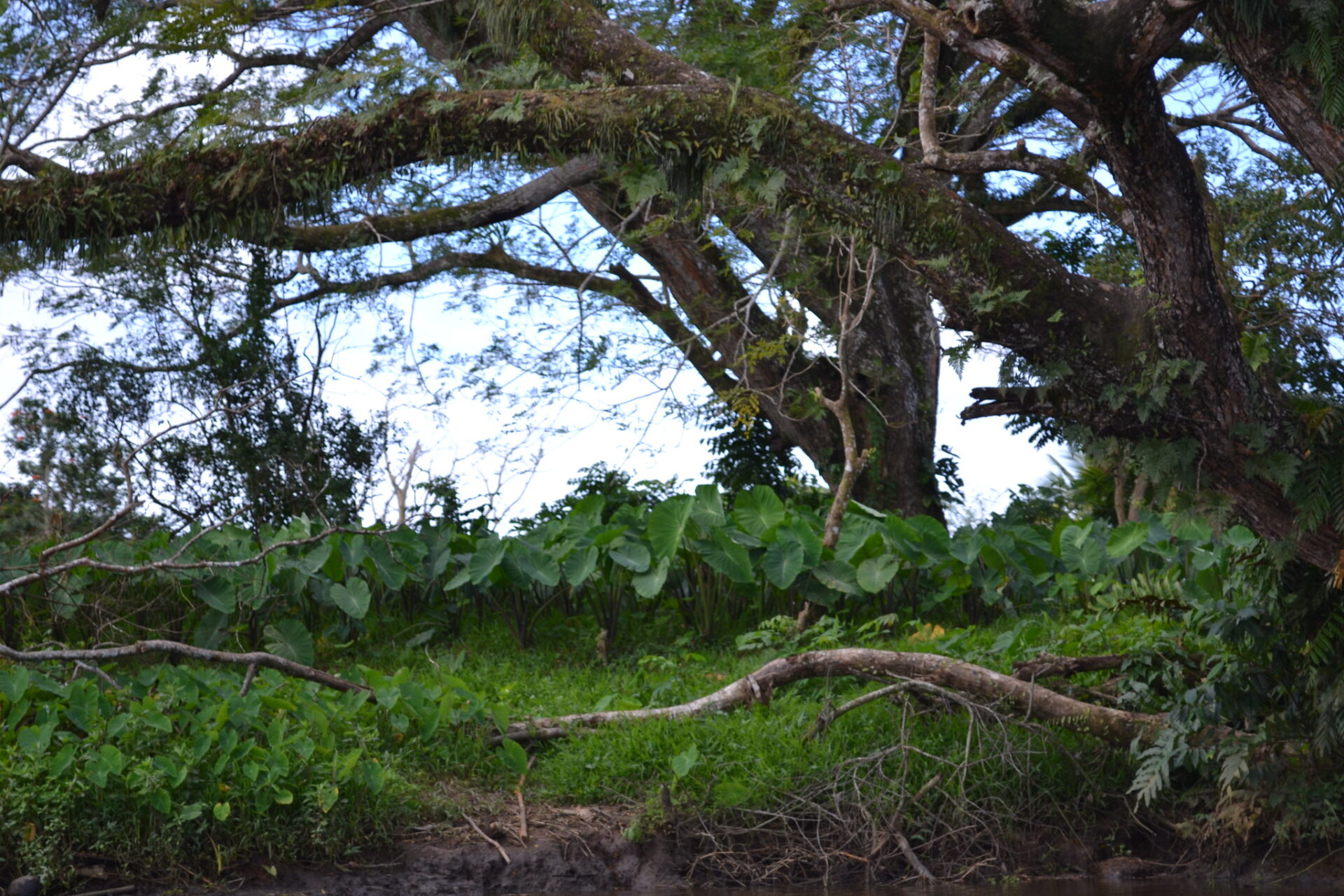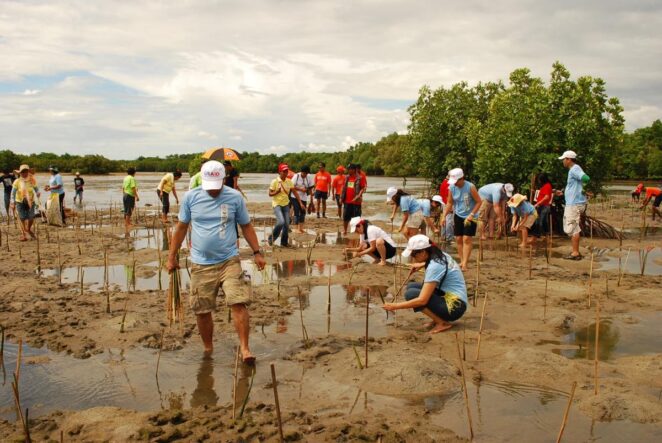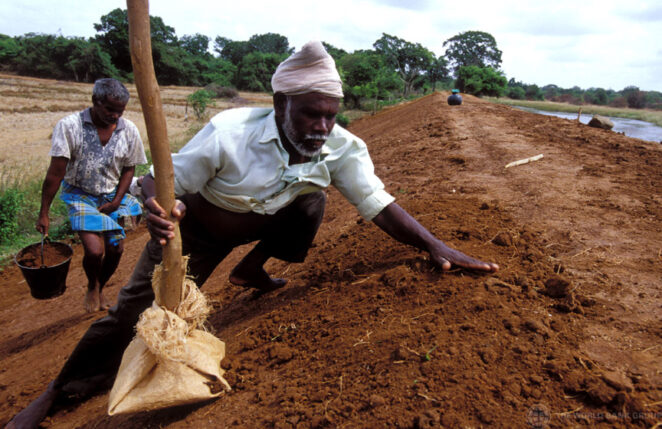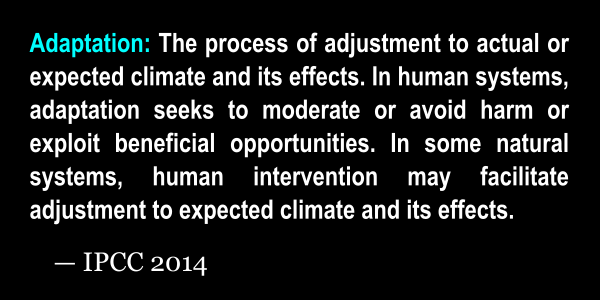An introduction to adaptation

- Level: Introductory
- Time commitment: 1-2 hours
- Learning product: Definitions
- Sector: Multi-sector
- Language: English
- Certificate available: No
Background
The impacts of climate changearebeingincreasinglyfelt around the world.Glaciers are in retreat, cities are overheating and there are various effects on hurricanes and tropical storms. Such impacts can trigger disasters and other adversity and hardship. Climate change adaptation is a means ofresponding to current climate hazardsas well as preparing for impacts that are linked to potentially even greaterwarming.However,climate change can also provideopportunities,and a vital part of adaptation is taking advantage of theseopportunities.
Examples of adaptation




Adapting to climate change involves structural, physical, social and institutional approaches.Adaptation activities includestructural and physical adaptation (i.e. engineering and built environment, technological, ecosystem-based and services); social adaptation (i.e. educational, informational, behavioural); and institutional adaptation (i.e.markets, laws and regulations, government policies and programmes).
These activities might include, for example:
- improvement of availability and accuracy of climate forecasts and services
- promoting theintroduction anduptakeofdrought-tolerant crops
- reforestationor otherland management practices to protectcoastalzones
- provision of technologies and training in climate-smartagriculture.
There is no exhaustive list of adaptation actions, however, examples are provided in tables for different sectors (inNoble et al.2014).
What is and what is not adaptation?Climate change adaptationis:
- A long-term view recognising current (competing)priorities
- Innovation, doing somethingdifferently
- Motivated and informed by climate factors and their interaction withother risks andtrends
- Choice of action explicitly considers current and future climateconditions
Adaptation isnot ‘business as usual’ development, norshort-term‘coping’ strategies,both of which canreduce risks butalsocarry‘maladaptation’ risks or may havelonger term trade-offs.
There are different levels of decisions and actionson adaptationfrom local to global.However, in practice, most adaptation happens at local levels.The local level is where the greatest needs are, as well as most of the expertise.Communities have always adapted to climate variation and change;what is new is the speed of changes taking place due to humanpressures.Community-based adaptation isan area of expertisethat is oftenthebest place to start understanding adaptationprocesses.
Climate adaptation isnowtaking place in every corner of the world. UNEP’s 2020Adaptation Gap Report reviewed almost 400 projects implemented using climate funds under theUnited Nations Framework Convention on Climate Change(UNFCCC); this is just a small but well documented sample of the overall activity. Global reviews such asthe Adaptation Gap Reporthelpto share lessonsacross projects and put themin a wider context. It is also important to understand how adaptation fits into the bigger pictureof climate change and development globally.
Global warming, adaptation and mitigation
Global warming -increase in globalaverage surface temperatureabove pre-industrial levels- is currentlyabout1.2 °Cand iscurrently on track toincrease by2.7 to 3.1°Cabove pre-industrial levelsby 2100 (Climate Action Tracker). However, the pace of changes in the earth’s natural and climate systems, and the effectiveness of policies to counteract these changes, are uncertain. Climate change mitigation which aims at reducing greenhouse gas emissions and removing them from the atmosphere, is needed to avoid dangerous climate change becoming a reality. Because mitigation and adaptation can (conceptually) be seen as prevention and cure to this problem, actions have tended to be undertaken separately. The United Nations Framework Convention on Climate Change (UNFCCC), adopted in 1992, focused mostly on mitigation.
However, climate change is an inter-related set of issues/problems. It can be thought of as a wicked policy problem: the search for straightforward answers or solutions is confounded by conflicting interests and different interpretations – the solutions proposed by different parties may be part of what defines the problem. For example, ‘loss and damage’ (L&D) has proved to be one of the most contested issues in the UNFCCC. Low income countries and their populations, which are particularly vulnerable to the adverse effects of climate change, argue that they must be financially compensated for unavoidable impacts of climate change for which they are not responsible. Rich nations, which have high historical emissions, argue that better sustainable development and more funding to climate adaptation must be used to reduce the risk of L&D. Part of the disagreement is semantic: what is ‘unavoidable’ and where is the line between adaptation and L&D? Part of it is political; does finance need to be in the form of compensation, without conditions, to “victims” of climate change, or should it not bear any liability and compensation claims?
Increasingly, climate change issues have come to be seen as development issues, and the least developed countries started to make adaptation a core demand at the UNFCCC negotiations (as well as compensation for L&D). Whilst scientists tend to work separately on adaptation and mitigation, it is now well-recognised that both kinds of expertise are needed for an effective science-based policy. The Paris Agreement, published in 2015, recognised the importance of pursuing both climate change mitigation and climate change adaptation. It includes a Global Goal on Adaptation which has accelerated national adaptation planning by committing to “enhancing adaptive capacity, strengthening resilience and reducing vulnerability to climate change”. It is helpful to further understand some of this terminology, which draws on a range of academic literature since the 90’s.
Defining adaptation

According to the Intergovernmental Panel on Climate Change (IPCC), adaptation is the process of adjustment to actual or expected climate and its effects. In human systems, it is the process of adjustment to actual or expected climate and its effects, in order to moderate harm or exploit beneficial opportunities. In natural systems, it is the process of adjustment to actual climate and its effects; human intervention may facilitate adjustment to expected climate (adapted by Global Centre for Adaptation based on IPCC AR5 Summary for Policymakers, 2014, p. 5 and IPCC AR5 Technical Summary, 2014, p. 40).
In the UNFCCC process, particularly from around 2008 with the Bali Plan of Action, we see a growing understanding of the necessity for adaptation in face of climate changes we are already committed to. Many of the older frameworks and concepts are unchanged in climate change adaptation (CCA) but in addition a number of newer ideas and terms have come into wider use.
Vulnerabilityis one of the most important concepts underpinning CCA.The IPCC defines vulnerability as “the propensity or predisposition to be adversely affected. Vulnerability encompasses a variety of concepts including sensitivity or susceptibility to harm and lack of capacity to cope and adapt”.See Glossary (IPCC,2014).Important conceptsof dynamic and multi-stressor vulnerability as well as framings fromnatural hazards researchthat proceeded and informed the IPCC definition are also useful background.
‘Loss and damage’ (L&D)refers to irreversible losses (e.g. loss of life, species, land) and costly damages (e.g. destroyed infrastructure, assets)from climate impacts.It includes impactsthat are not being tackled through adaptation and risk reduction strategies alone.The concept therebyrecogniseslimits to whatpeopleor natural systems can adapt to.
Adaptation limits - the IPCC Special Report on Global Warming of 1.5 ºC describes adaptation limits as the point at which an actor’s objectives (or system needs) cannot be secured from intolerable risks through adaptive actions.
- Hard adaptation limit: No adaptive actions are possible to avoid intolerable risks.
- Soft adaptation limit: Options are currently not available to avoid intolerable risks through adaptive action.
‘Climate resilience’ is a newer term which in some circles means the same thing as adaptation. The promotion of the term resilience “offers the opportunity for more holistic and proactive responses” (O’Brien et al., 2011) based on local knowledge and capacity. United Nations International Strategy for Disaster Reduction (UN/ISDR) has also adopted the term resilience, describing coping and recovery processes and but also the ability to adapt/change. See introduction to resilience for background.
Climate services is another relatively new termwhichsignifies a shift fromsupply-driven (i.e. science-driven)information products to ademand-driven production system that takes greater account ofusers’ needs and the different formatsof delivery.Climate services are varied in their structure and objectives. They areset up tohelp userscope with current climate variability and limit the damage caused by climate-related disasters.Theyalsocontribute to adaptation planning in a changing climate.Some examples can be found onthis theme on using climate information.
Transformative (sometimes termed transformational) adaptation is another concept that has emerged as counterpoint to incremental adaptation, sometimes seen as insufficient to tackle climate change.
- Incremental adaptation: Adaptation actions where the central aim is to maintain the essence and integrity of a system or process at a given scale.
- Transformational adaptation: Adaptation that changes the fundamental attributes of a system, often requiringachange in the objectives/functioning and potentially being disruptive(Kates et al. 2012; Lonsdale et al. 2015; Tàbara et al. 2019) E.g.
- Building a climate resilient city – Working Paper onTransformative adaptation in Southern African cities
- ODI’s report on Transformative adaptation in Africa’s agriculture
Maladaptation, on the other hand, is the counterpoint to successful adaptation. It describes the situation where adaptation interventions lead to an unexpected or unintended increase in climate risk or vulnerability in non-target groups or locations (Juhola et al. 2016).
These more recent concepts enrich the scientific discourse on climate change adaptation. They add to our existing understanding on the different nuances of concepts such as adaptation vs coping (ie. short term adjustment). There is also a deep intersection between adaptation and development – in terms of theconcepts, definitions andframeworks used–but also interms of thedesignofanintervention.Inclimate change adaptation, crucially,the choice of action explicitly considers current and future climate conditions in terms of risks and vulnerabilities, andthat’s what sets adaptation apart from ‘normal’ development. Climate change adaptation ispart ofthemove toward sustainable development andfrequentlyaims to deliver similar outcomes.
Measuring progress on adaptation
How is progress measured?Typically, adaptation projectshave multiple objectives focusingon reducingcurrent and futureclimate risks, increasing incomes, improving wellbeingandother benefits.Some projects may focus onbuilding awarenessandincreasingadaptive capacity which mayhelpimprove opportunities and/or strengthen institutions. These aimsreflectthe priorities ofthefunders, government and other stakeholders involved and not all are easily appraised. Project design documents (describing the outcome targets) and evaluations (measuring or appraising success against those targets), or research studies may use a range of tailored, or project-specific indicators to measure adaptation outcomes at different scales (e.g. individual, community, municipal) or in different sectors.
Measuring progress on adaptation is difficult because of the complexity of the projects, their entanglement with other social and economic factors and the fact that progress is only visible on longer timeframes. Whilst effectiveness of mitigation is commonly assessed as a measure of greenhouse gas emission reduction per unit of funding, no such metric is available for adaptation. However, there are a number of frameworks that have been successfully used , and guidance is available on how to tailor these frameworks to particular adaptation interventions. See for example:
- Frameworks forevaluating adaptation and their application, such asTAMD,AdaptME
- Review of indicator approaches(p.25-26)
- Guidance for developing indicators
Monitoring and evaluation of adaptation is also doneat higher levels of aggregation, for example nationally,sectorally oracross donor portfolios of development agencies (USAID etc.) or international climate funds (Green Climate Fund etc.). For further information see the introduction to monitoring and evaluation article.
There are also efforts to look at progress in planning for adaptation. The latest Adaptation Gap Report 2020, published in early 2021, found that mostcountries(72%) have nationalclimateplans, policies or other planning instrument in place. National adaptation planning(NAP) processesaresupported internationally by theNAP Global Network. TheNAP process was launched in Less Developed Countries (LDCs) in 2015, building on earlier National Adaptation Programmes of Action (NAPAs) which focused on “urgent and immediate adaptation needs”. Adaptation targets and planning are also an important component of the Nationally Determined contributions that countries are obliged to submit in support of the Paris Agreement on climate change.
The Paris Agreement also requires countries to report on progress made on these targets. The Global Stocktake is an instrument of the Paris Agreement which aims to periodically assess collective progress,and is important for increasing theglobal ambition for climate action on both adaptation and mitigation. Specifically on adaptation, it will recognise the adaptation efforts of developing countries, enhance implementation of adaptation, and review the effectiveness of adaptation. The Global Stocktake synthesis report is due in 2023, however current research suggests that the Global Goal on adaptation has not yet been operationalized and global adaptation governance is still weak.
TheAdaptation Gap Report 2020showed thatthere is still very limited evidence of climate risk reductionresulting from implementation of adaptation activities,although there isclear evidence of a rise in implementation.COVID-19is expected to negatively affect the ability of countries to plan, finance and implement activities on climate adaptation for many years to come.The financing of adaptation activities – high on the agenda of the UNFCCC since the beginning – is steadily increasing but the terms and principles of that funding have notmet climate justice demands of many partners.
Climate adaptation and national development planning strategies
NAPs, as well as countries’NDCs submitted so far showanincreasingcoherence with other national priorities for development planning (including SDGs etc) though this varies greatly from country to country. Important sectors where coordination is generally needed arewater, agriculture, environment, spatial & urban planning, infrastructure, and energy.How adaptation is integrated into each of theseareas,i.e.“mainstreaming”into establishedpolicies, plans, strategies andinstitutions is also a complicated question.On one hand,ifclimateadaptation concerns aretaken onboard indevelopment plans and policiesacross different sectors,then adaptation goals(of risk reduction, etc.) are more likely to be attained, and funding ismore likely to be effective.On the other hand, itbecomes moredifficult to identify which activities canactually be called “adaptation”, and whetherfundingis“new and additional”toother spending and budgets. This distinction isimportantformonitoring and evaluatinginternationalfunding for adaptation tolow- and middle-income countries.
Among the sectors which are most important toequip with an understanding ofadaptation are:disaster risk reduction and management; ecosystem management/Nature-basedSolutions; water management; and agriculture.For example,adaptation has strong relevance for disaster risk reductionand management (DRR/DRM).Many people considerthe main part ofCCA to beitselfpart of the longstanding effortonDRR,which is itself asub-field ofdevelopment.There arestrongsimilarities in the goals, strategies and actors involved. In the past two decades,climate changeadaptation has become an increasingly prominent and visible areafor research, planning and action.CCA’s political momentum and progress increating amechanism for international negotiations and agreements is somethingthat DRR could build on(e.g.through Sendai framework).Alignmentbetween the goals,policies andthe scientific work in the two areasishappening slowly and isnot keeping pace with theopportunities oropenings.Moreover,there is still a lot of confusion around the terminology employed – somewhat separately- in these fields,althoughtaxonomies are starting to appear as a basis for sharing data and knowledge.
A linkage of particular concern to developing countries is between adaptation and povertyreduction. Poverty is a keydriver ofsocial vulnerability which also underpinsmultiple climate risks.Climate changeimpactsdisproportionally affect poor people in low-income communities; if disastersoccur they canexacerbate poverty even further.
Climate adaptation examples under different themes on weADAPT
The IPCC(Oppenheimer et al, 2014)considers 3categories of actions to be (1)structural and physical adaptation (2)social adaptation; and (3) institutional adaptation. We can also consider actions withinimportantsectors as mentioned above.Somerecentlypublishedexamples of climate change adaptation researchunder different themes onweADAPT(e.gurban, community, national, nature-based)are:
Co-designing climate services to integrate traditional ecological knowledge: a case study from Bali, Indonesia. This report discusses efforts to help Indigenous People adapt to climate change by combining their traditional ecological knowledge with scientific and technological sources of information about agriculture and climate change. Read the complete Case Study on weADAPT
Integrating ecosystem-based adaptation and integrated water resources management for climate-resilient water management. This study explores how ecosystem-based adaptation and integrated water resources management can be merged to achieve greater climate resilience in watersheds. Read the complete Article on weADAPT
Transformative adaptation of rivers in an urban context: An ecological infrastructure and socio-ecological toolkit.Ecological infrastructure plays an important role in the overall health of rivers. This toolkit supports users to design, plan, implement and finance ecological infrastructure.
Read the complete Article on weADAPT
Co-designing climate services to support adaptation to natural hazards: two case studies from Sweden. Drawing on two Swedish case studies, this brief aims to understand how the co-design of climate services can support adaptation planning and decision-making. Read the complete Article on weADAPT
For other examples, please see the following pages:
- Adaptation inspiration book
- Adaptation country and sector cases
- See Case studies on weADAPT’s map interface
Further reading
There is a huge amount of literature available on adaptation. For overview material, a good place to start could be the synthesis products that summarise a lot of this work and experience, include a wide range of sources, and are based on the inputs of many contributors. There are a few high-level products such as:
The IPCC (Working Group II) reporting.
The Intergovernmental Panel on Climate Change (IPCC) produce regular syntheses of the state of knowledge on climate science and its implications for adaptation and mitigation actions. Five Assessment Reports (AR) have been published since establishment in 1988.
The latest synthesis report from the IPCC entitled Special Report: Global Warming of 1.5 ºc highlights outstanding knowledge gaps both in the underlying science on climate change impacts and our understanding of the pathways to action.
BRACED SR1.5 Guide for policymakers and practitioners
UNEP’s Adaptation Gap Report series
This series of reports (2014, 2016, 2017, 2018, 2020*) looks at the gap between implemented adaptation and the needs for adaptation – as defined by adaptation targets, plans, preferences and capacities in response to current climate change and future evolution.
*The latest Adaptation Gap Report 2020, which focused on Nature-based Solutions, was published in early 2021 (see also Global Adaptation Mapping Initiative)
Please find the most up to date glossaries that might help you interpret the world of climate change adaptation.
References
- Lonsdale, K., Pringle, P. & Turner, B. (2015) Transformative adaptation: what it is, why it matters & what is needed. UK Climate Impacts Programme, University of Oxford, Oxford, UK.
- O’Brien, K.(2012). Global environmental change II: from adaptation to deliberate transformation. Progress in Human Geography, 36(5): 667-676. DOI: https://doi.org/10.1177/0309132511425767
- Kates RW, Travis WR, Wilbanks TJ (2012) Transformational adaptation when incremental adaptations to climate change are insufficient. Proc Natl Acad Sci 109:7156–7161. https://doi.org/10.1073/pnas.1115521109
- Juhola, S., Glaas, E., Linner, B.O., Neset, T.S. (2016) Redefining maladaptation. Environmental Science and Policy 55:135-140
- Oppenheimer M, Campos M, Warren R, et al (2014) Emergent risks and key vulnerabilities. In: Climate change 2014: impacts, adaptation, and vulnerability. Part A: global and sectoral aspects. Contribution of Working Group II to the Fifth Assessment Report of the Intergovernmental Panel on Climate Change. In: White and LL (ed). Cambridge University Press, Cambridge, pp 1039–1099
- Khan, M., Robinson, Sa.,Weikmans, R. et al.(2020)Twenty-five years of adaptation finance through a climate justice lens. Climatic Change 161, 251–269.https://doi.org/10.1007/s10584-019-02563-x
- Vulturius, G. and Davis, M. (2016). Defining Loss and Damage: The Science and Politics Around One of the Most Contested Issues within the UNFCCC. Discussion Brief. Stockholm Environment Institute, Stockholm
- Noble, IR, S Huq, YA Anokhin, et al. (2014). “Adaptation Needs and Options.” In Climate Change 2014: Impacts,Adaptation, and Vulnerability. Part A: Global and Sectoral Aspects. Contribution of Working Group II to the Fifth Assessment Report of the Intergovernmental Panel on Climate Change, In: Field CB, Barros VR et al. (ed). Cambridge University Press, Cambridge, pp 833–68
-
Wikipedia contributors, “Climate change adaptation,” Wikipedia, The FreeEncyclopedia, https://en.wikipedia.org/w/index.php?title=Climate_change_adaptation&oldid=1027531386 (accessed June 11, 2021).
(0) Comments
There is no content